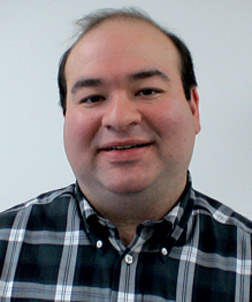Technique to Study Galaxies Earns Pitt Researcher U.S. Department of Energy Grant for Young Scientists
 Jeffrey Newman
Jeffrey NewmanA Pitt researcher developing a better technique to gauge the distance from Earth to some of the most distant galaxies in the visible universe recently received a five-year, $750,000 grant under a newly established federal program intended to support young scientists.
Jeffrey Newman, a professor of physics and astronomy in Pitt’s School of Arts and Sciences, was among 69 researchers nationwide—out of 1,750 applicants—selected for the U.S. Department of Energy’s Early Career Research program, an $85 million initiative funded under the 2009 American Recovery and Reinvestment Act. Awardees were chosen by peer review and include researchers from Cornell University, Harvard University, Massachusetts Institute of Technology, the University of Michigan, and Princeton University.
Newman—a nationally recognized expert on large astronomical datasets studying the distant universe—will refine a method he created to tap the full potential of observations by the world’s most powerful telescopes. The distance to a faraway galaxy is determined by measuring its redshift, or how its emitted light is stretched out by the universe’s expansion. These distances are vital in determining the nature of the as-yet undetected dark energy that appears to make up most of the universe’s mass and is causing it to expand faster over time. But the redshift of the farthest, faintest visible galaxies can only be gauged with indirect calculations. Estimations off by a mere 0.5 percent would result in an incorrect answer to what dark energy may be. Newman devised an algorithm to improve these measurements that in tests with simulated data kept errors below this threshold.
Newman’s technique will be critical for future projects such as the Large Synoptic Survey Telescope (LSST), a 14-year effort involving 23 universities including Pitt. The powerful telescope will record how the sky changes from night to night in a multicolor, movie-like format. The footage will allow for unprecedented study of elusive dark matter and dark energy, which has greater pull on the universe than dark matter. Newman’s work on the LSST is essential in studying these cosmic components and for determining how far back in the universe’s history the telescope is looking for each galaxy observed.
He also is on the executive committee of the All-wavelength Extended Groth Strip International Survey, or AEGIS, a massive project involving nearly 100 researchers worldwide to map a distant region of the universe—the Extended Groth Strip—and document the past 10 billion years of galactic evolution with telescopes around the world and in space. Newman will use data from the AEGIS project to test and perfect his algorithm.
Other Stories From This Issue
On the Freedom Road

Follow a group of Pitt students on the Returning to the Roots of Civil Rights bus tour, a nine-day, 2,300-mile journey crisscrossing five states.
Day 1: The Awakening
Day 2: Deep Impressions
Day 3: Music, Montgomery, and More
Day 4: Looking Back, Looking Forward
Day 5: Learning to Remember
Day 6: The Mountaintop
Day 7: Slavery and Beyond
Day 8: Lessons to Bring Home
Day 9: Final Lessons

